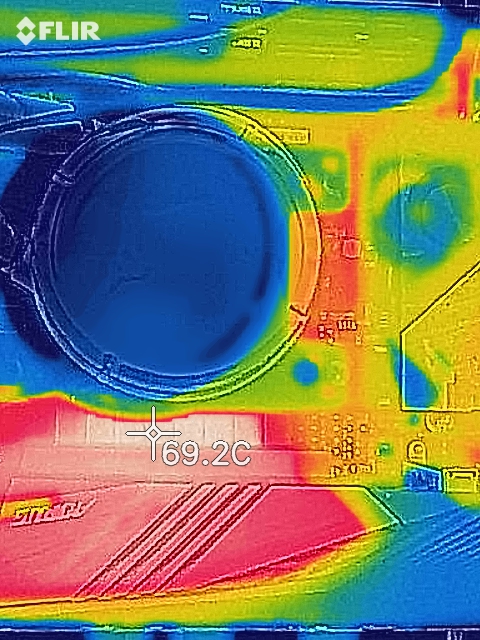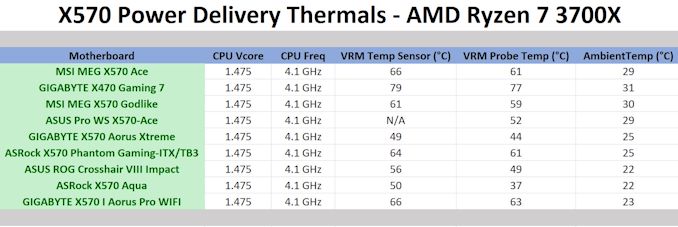On The Wings of an Eagle: GIGABYTE's X570 I Aorus Pro WIFI Motherboard Tested
by Gavin Bonshor on March 19, 2020 10:00 AM ESTPower Delivery Thermal Analysis
One of the most requested elements of our motherboard reviews revolves around the power delivery and its componentry. Aside from the quality of the components and its capability for overclocking to push out higher clock speeds which in turn improves performance, is the thermal capability of the cooling solutions implemented by manufacturers. While almost always fine for users running processors at default settings, the cooling capability of the VRMs isn't something that users should worry too much about, but for those looking to squeeze out extra performance from the CPU via overclocking, this puts extra pressure on the power delivery and in turn, generates extra heat. This is why more premium models often include heatsinks on its models with better cooling designs, heftier chunks of metal, and in some cases, even with water blocks.

The 6+2 power delivery on the GIGABYTE X570 I Aorus Pro WIFI motherboard
Testing Methodology
Out method of testing out if the power delivery and its heatsink are effective at dissipating heat, is by running an intensely heavy CPU workload for a prolonged method of time. We apply an overclock which is deemed safe and at the maximum that the silicon on our AMD Ryzen 7 3700X processor allows. We then run the Prime95 with AVX2 enabled under a torture test for an hour at the maximum stable overclock we can which puts insane pressure on the processor. We collect our data via three different methods which include the following:
- Taking a thermal image from a birds-eye view after an hour with a Flir Pro thermal imaging camera
- Securing three probes on to the rear of the PCB, right underneath CPU VCore section of the power delivery for better parity in case a probe reports a faulty reading
- Taking a reading of the VRM temperature from the sensor reading within the HWInfo monitoring application
The reason for using three different methods is that some sensors can read inaccurate temperatures, which can give very erratic results for users looking to gauge whether an overclock is too much pressure for the power delivery handle. With using a probe on the rear, it can also show the efficiency of the power stages and heatsinks as a wide margin between the probe and sensor temperature can show that the heatsink is dissipating heat and that the design is working, or that the internal sensor is massively wrong. To ensure our probe was accurate before testing, I binned 10 and selected the most accurate (within 1c of the actual temperature) for better parity in our testing.
For thermal image, we use a Flir One camera as it gives a good indication of where the heat is generated around the socket area, as some designs use different configurations and an evenly spread power delivery with good components will usually generate less heat. Manufacturers who use inefficient heatsinks and cheap out on power delivery components should run hotter than those who have invested. Of course, a $700 flagship motherboard is likely to outperform a cheaper $100 model under the same testing conditions, but it is still worth testing to see which vendors are doing things correctly.
Thermal Analysis Results

We measured 69.2°C on the hottest part of the board during our testing.
The hottest part of the heatsink was the MOSFETs
The GIGABYTE X570 I Aorus Pro WIFI is using a 6-phase power delivery for the processor with six Infineon TDA21472 70 A power stages and is controlled by an Infineon IR35201 PWM controller operating at 6+2. Cooling the board's power delivery is a small but capable heatsink which slots into the rear panel cover.
After running our VRM thermal tests, the GIGABYTE X570 I Aorus Pro WIFI performed well given the boards size in comparison to the boards we've previously tested. We observed temperatures of 66°C from the boards integrated thermal sensor, with our probes measuring 63°C attached to the rear of the power delivery. Our thermal imaging camera noted that the hottest part of the power delivery looking at the top of the board came from the MOSFETs, which we observed at just over 69°C. All our testing was done with our Ryzen 7 3700X processor and we expect the Ryzen 9 3950X processor to push the power delivery even further, and we wouldn't recommend using an overclocked 3950X in a system with this board without ensuring adequate airflow. This is due to the design of the heatsink which relies more on chassis with good airflow as opposed to a heatsink with a large mass.











63 Comments
View All Comments
InTheMidstOfTheInBeforeCrowd - Friday, March 20, 2020 - link
Oh, i don't doubt that. Even el cheapo fans can stay silent. For the first dozen months or so....ijozic - Friday, March 20, 2020 - link
IIRC, Asus X570-E doesn't have a chipset heatsink fan. I'd presume there are others, but that's one I've noticed.InTheMidstOfTheInBeforeCrowd - Friday, March 20, 2020 - link
Now, unfortunately that is neither mATX nor mITX. Also -- and this is obviously totally subjective -- does it feel normal to pay more for a motherboard than, say, for example a Ryzen 7 3700X?evernessince - Saturday, March 21, 2020 - link
Sure, assuming the fan isn't turned off completely. Passive mode exists and what many boards use when you aren't utilizing PCIe 4.0 bandwidth. I also have an old Z78 Sabertooth with an even smaller fan that's still perfectly functioning. Now that is a board built to last. In the end the quality of the fan really matters.InTheMidstOfTheInBeforeCrowd - Friday, March 20, 2020 - link
Yeah, this can work for people that build an entirely new system, thus being able to select components such CPU cooler and or GPU and a mobo with an acceptable layout (with regard to the placement of the chipset hub) so that they don't spatially interfere with each other.Unfortunately, i am intending to do an upgrade of an existing system instead of building a completely new one from scratch, and i intend to keep my GPU and CPU cooler. Both are too fat (wide/long) and are not leaving enough room for any passive chipset heatsink of any meaningful size :( (Form factor in my case is mATX or smaller. ATX and E(-peen)-ATX are not under consideration.)
PeachNCream - Friday, March 20, 2020 - link
I have to agree with you, moreso on the chipset fan than anything else. It feels like a significant step backwards to see them on motherboards and speaks of immature technology behind PCIe 4.0 to be in a state that the higher bandwidth bus requires active cooling.evernessince - Saturday, March 21, 2020 - link
It's in all the next gen consoles. I wouldn't call that immature.PeachNCream - Sunday, March 22, 2020 - link
And what sort of cooling do they have inside of them?Cashmoney995 - Thursday, March 19, 2020 - link
I currently cannot find an x570 Micro board with SP/DIF...still rocking my Z5500's from over a decade ago...Plenty of B450 board with this port, so wonder if this is a concious decision to segment the purchasers.supdawgwtfd - Thursday, March 19, 2020 - link
That interface is basically dead.Anything better than DVD provides better sound than it is capable of.